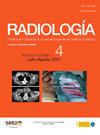快速心脏磁共振成像方案。在临床实践中使用压缩传感加速电影序列的可行性。
IF 1.1
Q3 RADIOLOGY, NUCLEAR MEDICINE & MEDICAL IMAGING
引用次数: 0
摘要
目的探讨压缩感应(CS)加速心脏磁共振(CMR)序列在心室解剖、体积和功能评估中的可行性;并提出了一个快速的CRM协议,提高了扫描效率。方法前瞻性研究连续有CMR指征的患者行CS短轴(SA)影像与常规SA影像比较。我们分析了射血分数(EF)、舒张末期容积(EDV)、卒中容积(SV)和心肌厚度。两位盲法独立观察者进行了阅读。计算了所有测量结果的观察者之间和观察者内部的一致性。并对常规和CS序列的图像质量进行了评价。结果共纳入50例患者,其中女性22例(44%),平均年龄57.3±13.2岁。参考稳态自由进动序列左室EF均值为59.1%±10.4%,CS组为58.7%±10.6%;常规影像右室EF为59.3%±5.7%,CS为59.5%±6.1%。常规序列和CS的平均左室EDV分别为166.8和165.1 ml;左室SV为94.5 vs 92.6 ml;右心室EDV分别为159.3 ml和156.4 ml;右心室SV分别为93.6 ml和91.2 ml。所有参数在观察者内和观察者间均具有良好的相关性(类内相关系数为0.932 ~ 0.99;置信区间:95%)。两组心室厚度也无显著差异(12.9±2.9 mm vs 12.7±3.1 mm) (p<;措施)。cssa的平均时间为<;40秒,而传统SA为6-8分钟。完整研究的平均持续时间为15±3分钟。结论科学CS序列可用于评估双心室功能,体积和解剖结构,实现快速CMR方案。本文章由计算机程序翻译,如有差异,请以英文原文为准。
Protocolo rápido de resonancia magnética cardiaca. Viabilidad de las secuencias cine aceleradas con compressed sensing en la práctica clínica
Objective
To demonstrate the feasibility of cardiac magnetic resonance (CMR) cine sequences with compressed-sensing (CS) acceleration in the assessment of ventricular anatomy, volume, and function; and to present a fast CRM protocol that improves scan efficiency.
Methods
Prospective study of consecutive patients with indication for CMR who underwent CS short-axis (SA) cine imaging compared with conventional SA cine imaging. We analysed ejection fraction (EF), end-diastolic volume (EDV), stroke volume (SV), and myocardial thickness. Two blinded independent observers performed the reading. Inter- and intraobserver agreement was calculated for all the measurements. Image quality of conventional and CS cine sequences was also assessed.
Results
A total of 50 patients were included, 22 women (44%) with a mean age of 57.3 ± 13.2 years. Mean left ventricular EF was 59.1% ± 10.4% with the reference steady-state free precession sequences, versus 58.7% ± 10.6% with CS; and right ventricular EF with conventional imaging was 59.3% ± 5.7%, versus 59.5% ± 6.1% with CS. Mean left ventricular EDV for conventional sequences and CS were 166.8 and 165.1 ml respectively; left ventricular SV was 94.5 versus 92.6 ml; right ventricular EDV was 159.3 versus 156.4 ml; and right ventricular SV was 93.6 versus 91.2 ml, respectively. Excellent intra and interobserver correlations were obtained for all parameters (Intraclass correlation coefficient between 0.932 and 0.99; CI: 95%). There were also no significant differences in ventricular thickness (12.9 ± 2.9 mm vs. 12.7 ± 3.1 mm) (p< .001). The mean time of CS SA was < 40 sec versus 6-8 min for the conventional SA. The mean duration of the complete study was 15 ± 3 min.
Conclusions
Cine CS sequences are feasible for assessing biventricular function, volume, and anatomy, enabling fast CMR protocols.
求助全文
通过发布文献求助,成功后即可免费获取论文全文。
去求助
来源期刊

RADIOLOGIA
RADIOLOGY, NUCLEAR MEDICINE & MEDICAL IMAGING-
CiteScore
1.60
自引率
7.70%
发文量
105
审稿时长
52 days
期刊介绍:
La mejor revista para conocer de primera mano los originales más relevantes en la especialidad y las revisiones, casos y notas clínicas de mayor interés profesional. Además es la Publicación Oficial de la Sociedad Española de Radiología Médica.
 求助内容:
求助内容: 应助结果提醒方式:
应助结果提醒方式:


